The best IT billing models for effective software development


Right, let’s talk about IT billing models. While fixed price and time-and-materials (T&M) contracts are often discussed, the landscape is far more complex. Two additional approaches complement the financial arrangements but are less commonly seen. To provide a comprehensive overview, we’ve compiled our insights in one place, ensuring each model receives equal attention. We’ll examine them all, breaking down their mechanics, advantages, disadvantages, and ideal use cases.
Table of contents
Fixed price model
With fixed price, you and the IT people agree on a set amount for the whole job before anything starts. Everything – what’s getting built, when it’s getting done, all that – is written down.
It’s good because you know what you’re paying, but if you want to change something later, it’s a whole new scope reestimation. And sometimes, the IT company, they might add a bit extra just in case things take longer than expected, so it can actually end up costing you more.
It works best when you know exactly what you want, no surprises, and you’ve got a tight budget. You know, like building a simple shed – you know the materials, you know the size, you know roughly how long it will take.
Cons of fixed price model
- Rigid scope: any deviation from the agreed-upon scope necessitates reestimation, which can be time-consuming and potentially costly;
- Risk of overestimation: providers may incorporate buffers into their pricing to mitigate potential risks, which can result in higher costs for the client;
- Limited flexibility: making adjustments during the project lifecycle can be challenging and complex.
Pros of fixed price model
- Predictable costs: this model offers budget certainty, making it suitable for clients with strict financial constraints;
- Clear deliverables: the defined scope and milestones ensure a structured and organised approach to project execution;
- Lower client involvement: Once the project starts, client involvement is minimal, freeing up their time and resources.
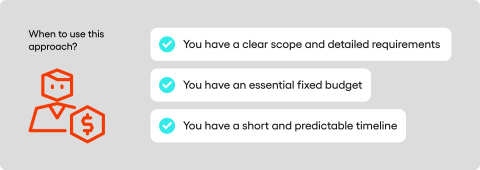
Time & Materials (T&M) model
T&M is different. You pay for the hours the IT team works and any materials they use. It’s more flexible, so if things change, it’s easier to adjust. But, it also means the total cost can be less predictable.
You need to keep an eye on things, you know, make sure it’s not going over budget. It’s like paying a builder by the hour – you have more control, but the final bill can be a bit of a surprise.
This model is good when you’re not quite sure what you need yet, or if you know there will be lots of changes along the way. Like, if you’re renovating a house and you’re not sure about the exact design yet.
Cons of Time & Materials (T&M) model
- Less predictable costs: the final cost can be higher than anticipated if the project scope expands or unforeseen issues arise.
- Requires oversight: clients need to be actively involved in monitoring project progress and resource allocation.
Pros of Time & Materials (T&M) model
- High Flexibility: This model is well-suited for iterative projects or those with evolving requirements.
- Adaptable to Changes: Accommodating changes mid-project is relatively straightforward.
- Efficient Collaboration: Clients can actively participate in decision-making throughout the development process.
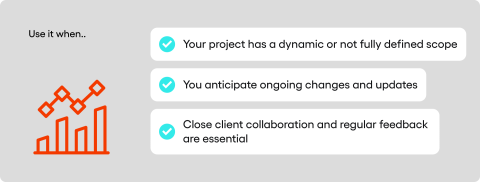
Hybrid model
A hybrid model is kind of a mix of the two. You have a fixed price for the main parts of the project, and then a variable cost for anything extra. So, you’ve got some predictability, but also some wiggle room.
It can be tricky to set up, you need to be really clear about what’s fixed and what’s variable, otherwise, you might have disagreements later. It’s like agreeing on a price for the main structure of the house, but then paying extra for any changes you make, like adding a new window or changing the layout.
It’s useful when you have a core set of features that are well-defined, but you also anticipate some changes or additions along the way.
Cons of Hybrid Model
- Complex setup: establishing a hybrid model requires detailed initial agreements and clear differentiation between fixed and variable components.
- Potential misalignment: misunderstandings regarding variable costs can lead to disputes between the client and provider.
Pros of hybrid model
- Balanced Approach: This model offers a compromise between the cost predictability of Fixed Price and the flexibility of T&M.
- Reduced Risk: It mitigates the risk of over- or underestimation compared to a purely Fixed Price model.
- Encourages Innovation: The flexible component allows for adaptation to new ideas and emerging requirements.
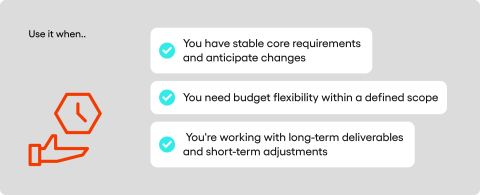
Outcome-based model
This one’s all about results. You pay based on what the project actually achieves, like, if it increases your sales or reduces your costs. It’s good because everyone’s on the same page about the goals, but it can be hard to measure, and sometimes things are outside the IT company’s control.
It’s best when you have very specific, measurable outcomes in mind, and you’re willing to work closely with the IT provider to achieve them. Imagine you’re hiring someone to build a website, and you only pay them if the website actually brings in a certain number of new customers. It’s all about the results, not just the work done.
Cons of outcome-based model
- High risk for providers: the provider’s success is dependent on factors that might be outside their direct control;
- Challenging setup: defining clear, quantifiable KPIs and agreeing on measurement methodologies can be a complex process;
- Longer onboarding: aligning expectations and establishing shared goals requires more time upfront.
Pros of outcome-based model
- Aligned Goals: both the client and provider are motivated by the same desired outcomes;
- Cost-Efficiency: clients only pay for demonstrated results;
- Innovation-Friendly: this model encourages providers to develop creative solutions to achieve the defined goals.
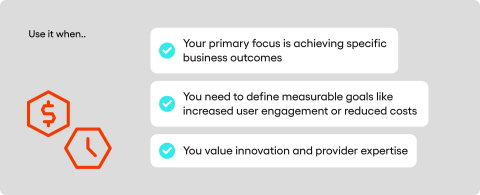
Comparison Table
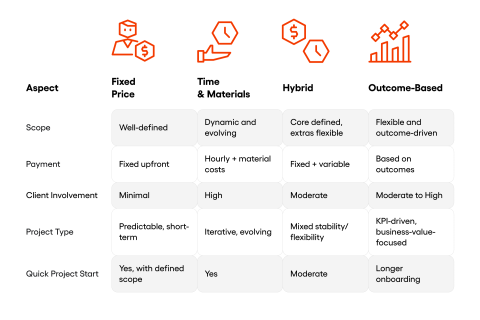
Conclusion
So, which one should you choose? Well, it depends on your project. If you know exactly what you want and have a tight budget, fixed price might be good. If things are likely to change, go for T&M. Hybrid is a good middle ground.
And if you’re focused on results, outcome-based could be the way to go. It’s worth talking to a few different IT providers to see what they recommend and get a feel for their approach. Don’t rush into anything, you know, it’s important to get it right.
Think about what’s most important to you – is it cost certainty, flexibility, or achieving specific results? Talking to the IT providers will also help you understand what’s realistic for your project and budget. They might even suggest a different approach you hadn’t thought of.
And don’t be afraid to ask lots of questions. The more you understand, the better equipped you’ll be to make the right decision.
FAQ
What are the different IT billing models available?
Several different pricing models exist for IT projects, including fixed price, usage-based pricing, tiered pricing, hybrid, and outcome-based pricing.
How does the fixed price model work, and when should I consider it?
The fixed price model involves agreeing on a set price for the entire project upfront. It’s best suited for projects with a well-defined scope, predictable timelines, and tight and strict deadlines, where the development process is clearly understood.
What are the advantages and disadvantages of the fixed price model?
Advantages include predictable revenue stream for the service provider and budget certainty for the client. Disadvantages include limited flexibility for changes and the potential for higher costs due to built-in buffers.
When is the time & materials (T&M) model the right choice?
The T&M model, where clients pay for actual hours worked and materials used, is suitable for projects with evolving requirements, unclear scopes, or where flexibility is paramount.
What is a hybrid pricing model, and how does it combine fixed and variable costs?
A hybrid pricing model combines a fixed price for core deliverables with variable costs for additional features or changes. This offers a balance between predictability and flexibility.
How does the outcome-based pricing model differ from other models?
The outcome-based model ties payments to the achievement of specific, measurable outcomes or KPIs, rather than just the delivery of features. This model is focused on customer satisfaction and customer retention.
What are some common SaaS pricing models?
Common SaaS pricing models include tiered pricing, usage-based billing, freemium model, flat rate, and value-based pricing.
How do I determine the right pricing strategy for my software development project?
Choosing the right pricing model involves considering factors like project scope, budget, timeline, desired flexibility, target market, and competitor pricing. Analysing customer usage and customer feedback is also crucial.
What is tiered pricing, and how does it work?
Tiered pricing offers multiple pricing tiers with different levels of features, usage limits, or the number of users. Pricing tiers allow you to cater to different customer segments.
What is usage-based pricing, and how is it calculated?
Usage-based pricing means paying customers are charged based on their actual usage of the product or service, such as API calls, data usage, or cloud services consumed.
What is the dedicated team pricing model, and what are its benefits?
The dedicated team model involves hiring a dedicated team of developers for a fixed monthly fee. This is beneficial for long-term projects requiring specialised expertise.
How can I effectively communicate my pricing model on my pricing page?
Your pricing page should clearly outline your pricing plans, premium features, and the perceived value of each tier. Highlighting the benefits of each plan for specific customer segments is crucial. Consider offering a free tier or free users access to attract price sensitive customers. Be transparent about the pricing model determines how much customers pay.
How do sales negotiated contracts differ from standard pricing models?
Sales negotiated contracts allow for customised pricing and terms for specific customers, often enterprise clients, and may include volume discounts or other special arrangements.
How can I use pricing to improve customer acquisition and customer retention?
Offering a freemium model or free tier, along with competitive pricing structures and various pricing models, can attract new customers (customer acquisition). Providing excellent value, responsive support, and evolving your pricing strategy based on customer feedback and usage patterns can improve customer retention and customer loyalty. Consider offering more advanced features in higher pricing tiers.
How can I analyse competitor pricing to inform my own pricing strategy?
Analysing competitor pricing helps you understand the market landscape and identify opportunities to differentiate your offerings. Consider the value you provide compared to competitors when setting your prices.
How do I determine project costs for different pricing models?
Calculating project costs varies depending on the billing model. For fixed price projects, estimate all resources and time required. For T&M, track hours worked and material costs. For outcome-based, estimate the cost of achieving the desired outcomes. For the dedicated team model, factor in the salaries and overhead of the team members.
How can I implement a new pricing strategy for existing customers?
Introducing a new pricing strategy for existing customers requires careful planning and communication. Consider grandfathering existing customers at their current rates for a period or offering incentives to switch to the new model. Gather customer feedback and be prepared to address any concerns.
How do I manage the financial risks associated with different software development pricing models?
Managing financial risks involves accurately estimating project costs, clearly defining scope, and maintaining open communication with clients. For T&M projects, closely monitor usage data and API calls. For outcome-based pricing, establish clear KPIs and measurement methods. For fixed price model, make sure you account for the entire project and development process. For dedicated team model, ensure you have a consistent flow of work for the team.
How can I use pricing to maximise profitability in software development?
Maximising profitability requires a deep understanding of your costs, your target market, and the value you provide. Experiment with different pricing models and pricing tiers to find the optimal balance between revenue and customer acquisition. Continuously monitor your customer usage and pricing plans and adjust your pricing strategy as needed. Ensure you have a good project manager to oversee the development team and ensure the project stays on track and within budget.
This blog post was created by our team of experts specialising in AI Governance, Web Development, Mobile Development, Technical Consultancy, and Digital Product Design. Our goal is to provide educational value and insights without marketing intent.




